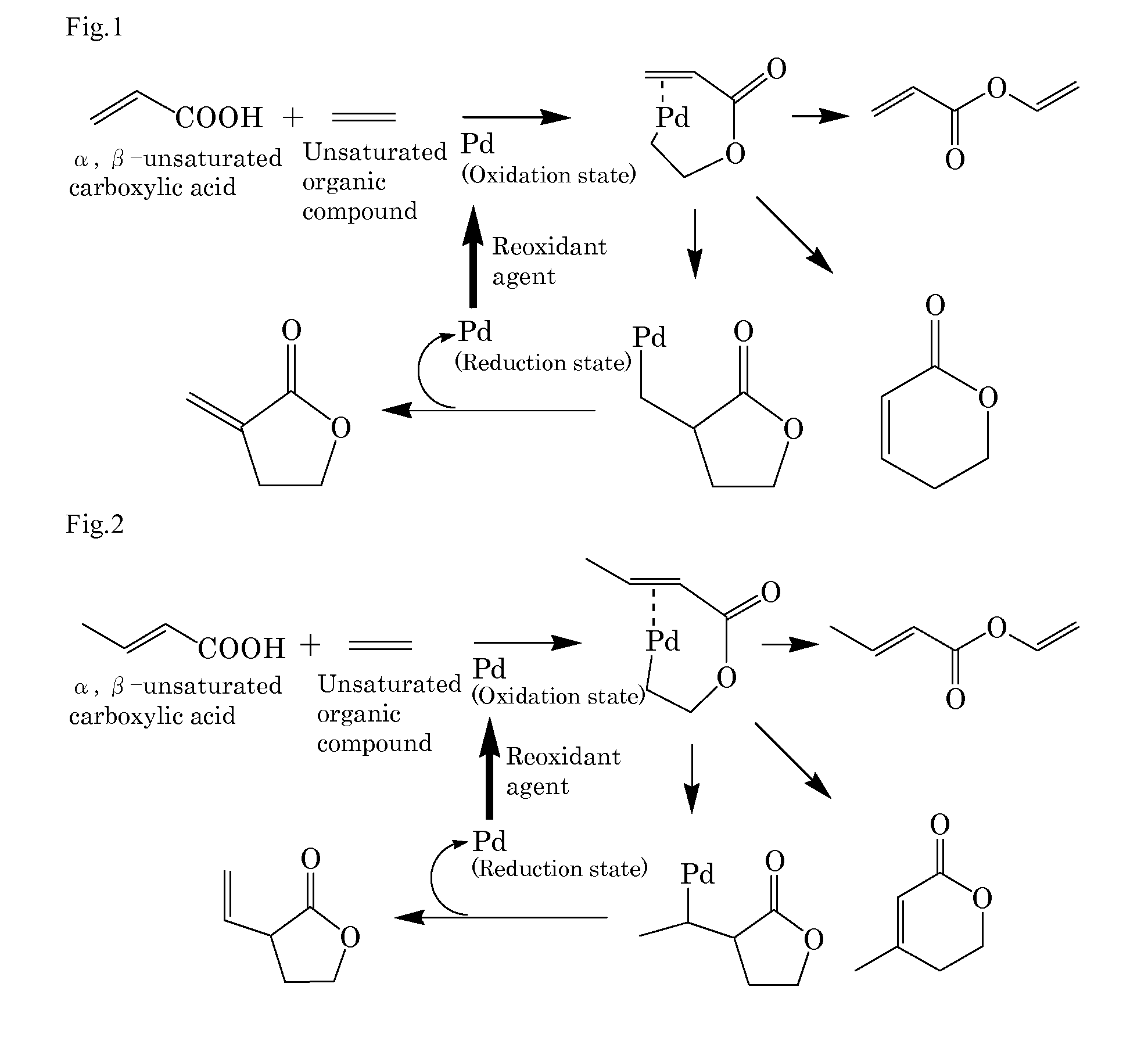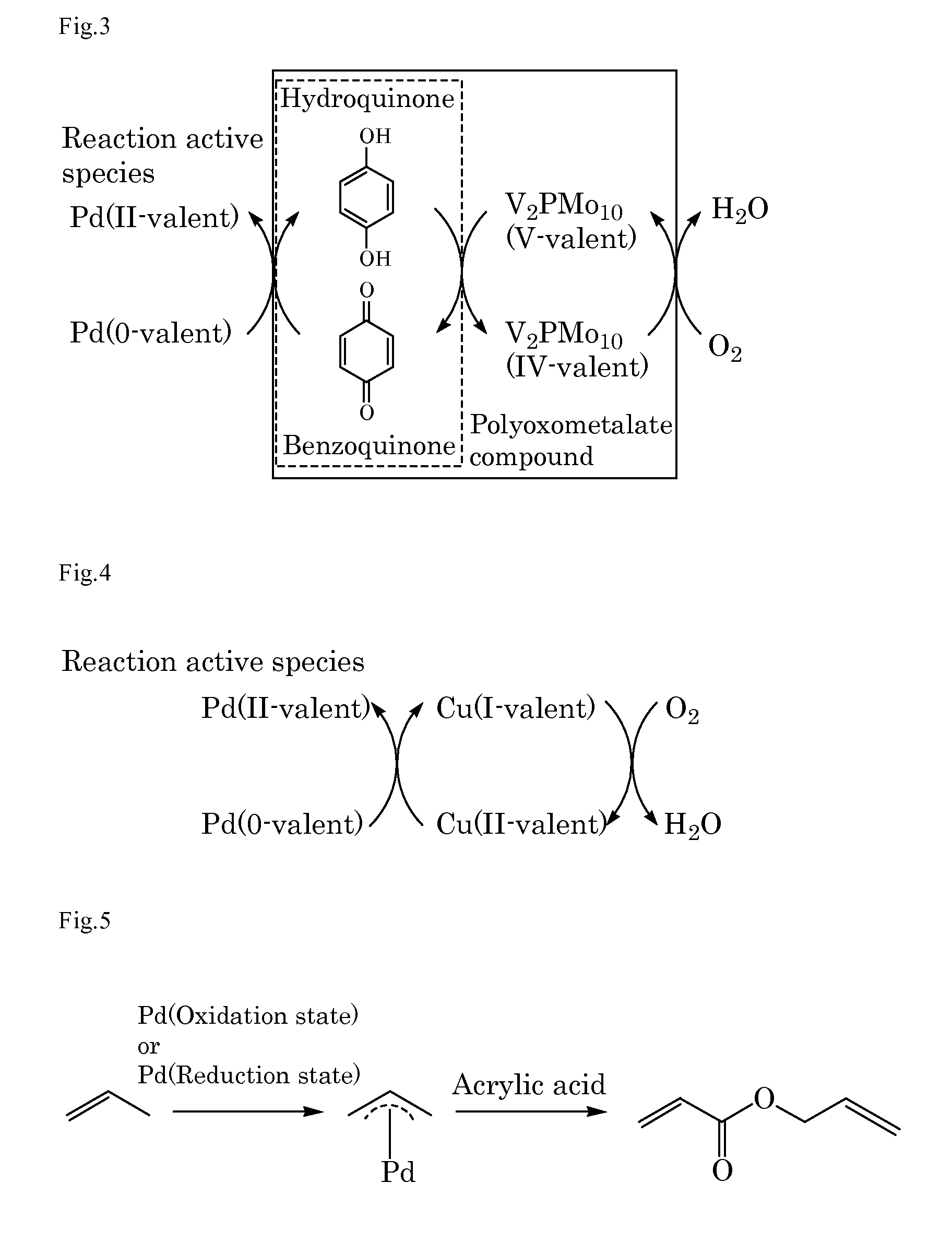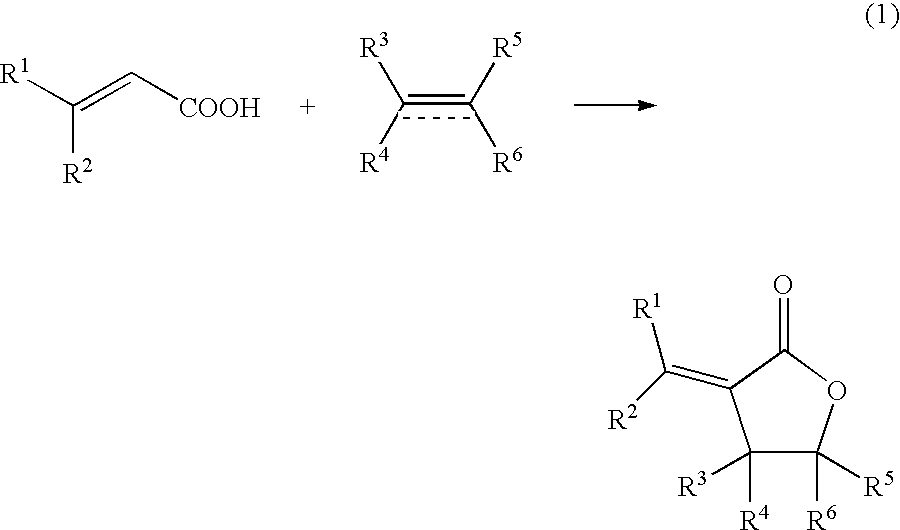Method for producing cyclic unsaturated compound
a technology of unsaturated compounds and unsaturated compounds, which is applied in the direction of organic compounds/hydrides/coordination complexes, physical/chemical process catalysts, metal/metal-oxides/metal-hydroxide catalysts, etc., can solve the problems of deterioration of catalysts, and inferior methods in cost and safety
- Summary
- Abstract
- Description
- Claims
- Application Information
AI Technical Summary
Benefits of technology
Problems solved by technology
Method used
Image
Examples
example 1
[0218]Into a 10 mL autoclave, acrylic acid (0.43 g, 6.0 mmol) as the α,β-unsaturated carboxylic acid, benzoquinone (0.22 g, 2.0 mmol), sodium acrylate (2.7 mg, 0.03 mmol) as the basic compound, palladium acetate (11.2 mg, 5 mol %) as the compound including at least one element selected from the group consisting of elements of the Groups 8 to 12, ethylene gas (28 mg, 1.0 mmol) as the unsaturated organic compound, and N-methylpyrrolidone (NMP) (3 mL) as the solvent were added. The gas phase was composed of 0.5 kg / cm2 of nitrogen gas and 3.5 kg / cm2 of oxygen gas and the mixture was stirred at 50° C. for 16 hours. After cooling, the reaction mixture was analyzed by gas chromatography. The desired product was obtained in a 25% yield. FIG. 1 schematically shows a possible reaction mechanism in Example 1.
[0219]Also in Examples 2 to 18, the reaction was performed by the same production method as in Example 1 except that the proportion and the reaction conditions shown in Table 1 were change...
example 19
[0220]A catalyst was prepared by flowing 2.75% oxygen / nitrogen standard gas (flow rate: 500 mL / min) into an egg shell type 5% Pd / activated carbon (5 g) (product of Johnson Matthey), at 400° C. for 8 hours. Into a 10 mL autoclave, acrylic acid (3.0 g, 42 mmol) as the α,β-unsaturated carboxylic acid, the above-mentioned catalyst (0.2g, 10 mol %) as at least one element selected from the group consisting of elements of the Groups 8 to 12, and p-methoxyphenol (3 mg) were added. Then, 0.5 kg / cm2 of nitrogen gas, 3.5 kg / cm2 of oxygen gas, and ethylene gas (28 mg, 1.0 mmol) as the unsaturated organic compound were added into the gas phase. The mixture was stirred at 80° C. for 16 hours. After cooling, the gas phase was purged and the reaction mixture was analyzed by gas chromatography. The yield of α-methylene-γ-butyrolactone was 15% and that of vinyl acrylate was 18%.
example 20
[0221]A catalyst was prepared by flowing 2.75% oxygen / nitrogen standard gas (flow rate: 500 mL / min) into an egg shell type 5% Pd / activated carbon (5 g) (product of Johnson Matthey), at 300° C. for 8 hours. Into a 10 mL autoclave, acrylic acid (3.0 g, 42 mmol) as the above-mentioned α,β-unsaturated carboxylic acid and the above-mentioned catalyst (0.2g, 10mol %) as the at least one element selected from the group consisting of elements of the Groups 8 to 12, and p-methoxyphenol (3 mg) were added. Then, 0.5 kg / cm2 of nitrogen gas, 3.5 kg / cm2 of oxygen gas, and ethylene gas (28 mg, 1.0 mmol) as the unsaturated organic compound were added into the gas phase. The mixture was stirred at 80° C. for 16 hours. After cooling, the gas phase was purged and the reaction mixture was analyzed by gas chromatography. The yield of α-methylene-γ-butyrolactone was 10% and that of vinyl acrylate was 19%.
PUM
| Property | Measurement | Unit |
|---|---|---|
| temperature | aaaaa | aaaaa |
| temperature | aaaaa | aaaaa |
| temperature | aaaaa | aaaaa |
Abstract
Description
Claims
Application Information
 Login to View More
Login to View More - R&D
- Intellectual Property
- Life Sciences
- Materials
- Tech Scout
- Unparalleled Data Quality
- Higher Quality Content
- 60% Fewer Hallucinations
Browse by: Latest US Patents, China's latest patents, Technical Efficacy Thesaurus, Application Domain, Technology Topic, Popular Technical Reports.
© 2025 PatSnap. All rights reserved.Legal|Privacy policy|Modern Slavery Act Transparency Statement|Sitemap|About US| Contact US: help@patsnap.com



